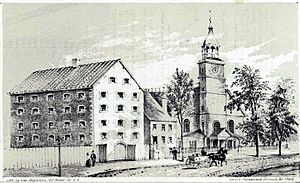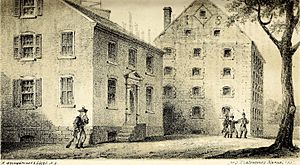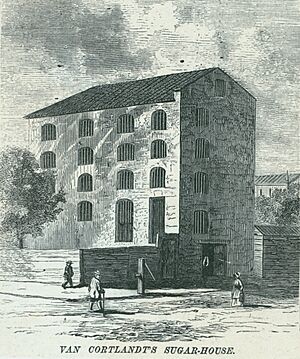Sugar house prisons in New York City facts for kids

During the American Revolutionary War, buildings called Sugar Houses in New York City were used as prisons by the British army. These buildings were originally warehouses for storing sugar and molasses. After the British took over New York City, they needed places to hold the many American soldiers they captured.
Conditions in these makeshift prisons were very harsh. For example, out of 2,600 American soldiers captured during the Battle of Fort Washington in November 1776, about 1,900 died in the following months. It's thought that at least 17,500 American prisoners died in sugar houses and British prison ships throughout the war. This number is more than double the number of American soldiers killed in battles.
Contents
What Were Sugar Houses?
In the 1700s, New York City was a major trading hub, especially with the British West Indies. Merchants would import sugar and molasses from places like Jamaica and Sint Eustatius. They stored these goods in large warehouses, often called "sugar houses," before they were refined into sugar. Important families like the Livingstons and Rhinelanders owned many of these buildings.
When the British army occupied New York City during the American Revolution, they turned some of these large sugar houses into prisons for captured American soldiers. Three of the most well-known sugar house prisons were owned by the Livingston, Rhinelander, and Van Cortlandt families.
Life Inside the Sugar House Prisons
Livingston's Sugar House
The Livingston sugar house was a six-story stone building on Crown Street, which is now Liberty Street in Manhattan. It was built in 1754. At first, it held about 40 to 50 prisoners, but soon the number grew to 400 or even 500. The floors were very low, making the space cramped and uncomfortable.
Food was scarce and often bad. Prisoners received pork and sea biscuits, which were frequently moldy and full of worms. Even so, the starving prisoners usually ate it, sometimes boiling it to remove the parasites. If prisoners got sick, the American government tried to send supplies, as the British provided almost nothing. Many prisoners died from illness. Their bodies were sewn into blankets and left in the yard for a "dead cart" to pick up each morning. Sometimes, as many as fifteen bodies would be waiting in one day.
Prisoner exchanges were sometimes arranged, with the oldest prisoners usually being released first. The Livingston sugar house was torn down in 1846. Today, buildings at 34 and 36 Liberty Street stand on its former site.
In Lower Manhattan, near Trinity Churchyard, there is a monument called the Soldiers' Monument. A plaque on it mentions the "great and good Men who died whilst in Captivity in the old [Livingston] Sugar House."
Rhinelander's Sugar House
The Rhinelander sugar house was a five-story brick warehouse. It was built in 1763 by William Rhinelander on the corner of Rose Street (now William Street) and Duane Street in Lower Manhattan. It was used to store molasses and sugar. Many historians believe the British army used it as a prison during the Revolutionary War.
This building was the last of the sugar house prisons to remain standing. It was finally torn down in 1892. For a long time, locals believed the old warehouse was haunted by the ghosts of prisoners who died there. When a new building, the Rhinelander Building, was built on the site, it kept part of the original wall. People still reported seeing ghostly figures in a window there until 1968.
Today, the headquarters of the New York City Police Department is on this site. One of the original barred windows from the sugar house was saved and is displayed nearby. Another section of the wall with a window was moved to Van Cortlandt Park in the Bronx.
Van Cortlandt's Sugar House
The Van Cortlandt sugar house was located on the northwest corner of the yard of Trinity Church in Manhattan. John Van Cortlandt and George Petterson built it around 1755. Like the other sugar houses, it was used as a prison during the American Revolutionary War. This building was torn down in 1852.
Images for kids




